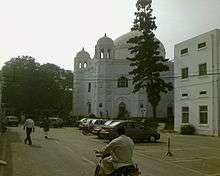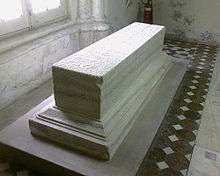Sahib Jamal
Sahib Jamal (Persian: صاحب جمال; died c. 25 June 1599) was the third wife of Prince Salim Mirza, the future Mughal emperor Jahangir. She was the mother of Salim's second son, Prince Parviz.[2]
| Sahib Jamal | |||||
|---|---|---|---|---|---|
| Begum-i-Padishah بیگم پادشاه | |||||
 The tomb of Sahib Jamal in Lahore | |||||
| Born | Herat, Afghanistan | ||||
| Died | c. 25 June 1599[1] Lahore, Pakistan | ||||
| Burial | Tomb of Sahib Jamal, Lahore | ||||
| Spouse | Jahangir (pre-accession) | ||||
| Issue | Sultan Parviz Mirza | ||||
| |||||
| House | Timurid (by marriage) | ||||
| Father | Khwaja Hasan | ||||
| Religion | Islam | ||||
Family
Sahib Jamal was of Turkish origin[3] and was the daughter of a respected Muslim religious personality, Khwaja Hasan of Herat, making her the cousin of Zain Khan Koka, who was a leading official in the Mugal Empire under Akbar, including serving for a time as governor of Kabul.[4] Her father, Khwaja Hasan, was known widely for his scholarship and studies in the techniques of warfare. Akbar held him in high esteem, and often discussed with him the spiritual problems that often agitated his mind.[5] Zain Khan's daughter, Khas Mahal was also married to Jahangir.[6]
Sahib Jamal was a beautiful,[7] highly cultured and well educated woman, who was fully conversant with the rules and etiquettes of the palace.[5]
Marriage
Salim had fallen in love with her and they got married in October 1589,[8] in a lavish and grand marriage ceremony. Upon her marriage, she was given the title "Sahib Jamal", which literally means ("Paragon of Beauty") or ("Mistress of Beauty") which was chosen by Akbar himself, by which name she came to be styled thereafter.[9]
Sahib Jamal bore her husband two children: his second son, Sultan Parviz Mirza, as well as a daughter, who died in infancy.[5]
In 1596 Salim became violently enamoured of Khas Mahal, the daughter of Zain Khan, and meditated marrying her. Akbar was displeased at the impropriety. The cause of Akbar's objection was Sahib Jamal who had already been married to Salim. Akbar objected to marriages between near relations. However, when Akbar saw that Salim's heart was immoderately affected, he, of necessity, gave his consent.[10]
Death and burial place
Sahib Jamal died c. 25 June 1599 in Lahore, present-day Pakistan, and was also buried there. Construction of her tomb dates to either 1599 C.E. or 1615 C.E.[11]
There is a popular misconception that the Tomb of Sahib Jamal in Lahore is the tomb of the legendary dancing girl Anarkali. As per the legend, the tomb was said to be built by the Mughal emperor Jahangir for his love Anarkali, who was caught by Emperor Akbar for exchanging glances with Jahangir, at the time known as Prince Salim. Anarkali was reportedly a concubine of Akbar, and this action reportedly enraged Akbar so much, that he had Anarkali interred alive in a wall. When Prince Salim ascended the throne and took the name "Jahangir," he is reported to have ordered the construction of a tomb over the site of the wall in which Anarkali was reportedly buried.[11]
18th century historian Abdullah Chagatai reported that the tomb was not the resting place for Anarkali, but instead for Jahangir's beloved wife Sahib Jamal.[11] Many modern historians accept the credulity of this account.[12] The building is currently used as the Punjab Archives, so access to the public is limited.

Sahib Jamal's white marble cenotaph features carvings with the 99 names of Allah, and was described by 19th century historians as "one of the finest pieces of carving in the world."[13]
In addition to the 99 names of Allah, the cenotaph is inscribed with a Persian couplet written by the Emperor Jahangir which reads: "Ah! could I behold the face of my beloved once more, I would give thanks unto my God until the day of resurrection."[12]
References
- Thackston, Wheeler M., ed. (1999). The Jahangirnama : memoirs of Jahangir, Emperor of India. Translated by Thackston. New York [u.a.]: Oxford Univ. Press. p. 8. ISBN 9780195127188.
- Balabanlilar, Lisa (2012). Imperial Identity in the Mughal Empire : Memory and Dynastic Politics in Early Modern South and Central Asia. London: I.B. Tauris. p. 10. ISBN 9781848857261.
- Shujauddin, Mohammad; Shujauddin, Razia (1967). The Life and Times of Noor Jahan. Lahore: The Caravan Book House. p. 71.
- Findly, Ellison Banks (1993). Nur Jahan: Empress of Mughal India. Oxford University Press. pp. 124 125. ISBN 9780195360608.
- Lal, Muni (1983). Jahangir. New Delhi: Vikas. pp. 27 28. ISBN 9780706922714.
- Desai, Ziyaud-Din A. (2003). Purā-prakāśa: Recent Researches in Epigraphy, Numismatics, Manuscriptology, Persian Literature, Art, Architecture, Archaeology, History and Conservation: Dr. Z.A. Desai Commemoration Volume, Volume 1. Bharatiya Kala Prakashan. p. 281. ISBN 978-8-180-90007-5.
- Lal, K.S. (1988). The Mughal harem. New Delhi: Aditya Prakashan. p. 27. ISBN 9788185179032.
- Awangābādī, Shāhnavāz Khān; Prasad, Baini; Shāhnavāz, 'Abd al-Hayy ibn (1979). The Maāthir-ul-umarā: Being biographies of the Muḥammadan and Hindu officers of the Timurid sovereigns of India from 1500 to about 1780 A.D. Janaki Prakashan. p. 1023.
- Prasad, Beni (1940). History of Jahangir (3 ed.). Indian Press, Limited. p. 26.
- Beveridge, Henry (1907). Akbarnama of Abu'l-Fazl ibn Mubarak - Volume III. Asiatic Society, Calcutta. pp. 1058–9 n. 3.
- "Legend: Anarkali: myth, mystery and history". Dawn. 11 February 2012. Retrieved 23 August 2016.
- "Anarkali's Tomb". Lahore Sites. Retrieved 23 August 2016.
- Eastwick, Edward Backhouse (1883). Handbook of the Punjab, Western Rajputana, Kashmir, and Upper Sindh. London: John Murray, Albemarle Street.